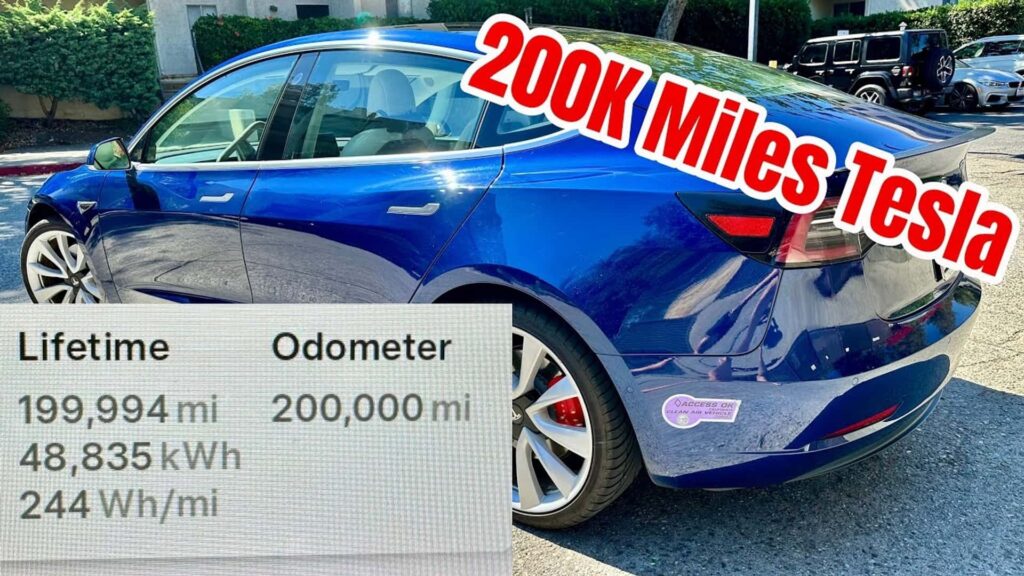If you own an electric vehicle then you’re probably sick and tired of the anti-EV crowd telling you how much you hate your electric car. One of the oldest lies is some variation of “you’ll have to get a new battery every 75,000 miles”. It is a practically ancient line of attack for social media trolls. And as anyone driving a modern EV with a 60 kWh+ pack like a Tesla Model 3 will tell you: this supposed EV reliability concern is completely untrue.
We now have more than enough evidence to show that batteries will provide a usable driving range for hundreds of thousands of miles. A case in point is the driver of this 2018 Tesla Model 3 Performance who has put 200,000 miles on his car’s original pack in less than six years.
EV Batteries Are Easily Outlasting Their Battery Warranty
Like most of these electric vehicle attacks, they’re usually based on one particular model’s failure or a one-off issue that a single user has encountered. Specifically, the first-generation Nissan Leaf was an otherwise decent electric car that had terrible battery reliability due to the car’s small pack size and lack of thermal management. While a few other early low-volume and compliance EVs suffered major range loss in the first 100,000 miles, it has not been an issue with the majority of plug-in models. The industry learned quickly from automakers that embraced liquid-cooled, lithium-ion battery packs like General Motors and Tesla. The average 10+ year old Tesla Model S and Chevrolet Volt will see 200,000 miles with well over 75% of their range still intact.
Not much has changed regarding the car’s reliability or range in the last 50,000 miles. As is typical with electric cars, the largest amount of degradation occurs in the first 75,000 miles of the battery’s life. After that, batteries tend to lose their capacity at a much slower rate.
When it comes to useable driving range, he hasn’t noticed any difference at all in the past 100,000 miles. He tracks his battery health in a number of ways which all provide slightly different analyses of his vehicle’s health. One way he tests is by tracking how many kWh the car can draw in a 0-100% Supercharging session. In fact, according to the car’s owner, almost all of his charging is at Supercharging stations from a low state of charge up to 95 or 100%.
At 200,000 miles, the car’s battery will accept roughly 66 kWh. So if the degradation test is based on the official 75 kWh useable pack size, then he has seen 11-12% degradation. However, there are a lot of inefficiencies to consider that can impact charging losses so this number is not exact.
RecurrentAuto’s report gives his Model 3 a score of 85%. According to Recurrent, the score is “a percentage that compares a vehicle’s current max range to the original range for that make, model and battery pack configuration.” So this is not entirely indicative of capacity loss. Differences in driving style, location, weather, and other drivetrain components can impact driving range as well as the battery pack health.
Between these two methods, we can get a pretty good picture that the battery pack degradation is likely between 11 and 15%. If we assume the vehicle has lost about 13% of its capacity, then the formerly 310-mile Model 3 Performance today has a range of about 270 miles. Possibly a few miles less depending on the wheel and tire configurations.
That’s not to say the vehicle hasn’t been completely free of issues. Early on he had to repair a noisy upper control arm, and after 100,000 miles he had to get the car’s supercharging hardware serviced. This was most likely due to his rather excessive use of fast charging.
Tires have lasted 40,000-50,000 miles except when one is lost due to a nail in the sidewall. And he’s still running the original brake pads and has yet to change the brake fluid. He will likely be getting his A/C serviced soon, however. While it is still pumping cool air, it is not cooling the vehicle as effectively as when new.
For early-generation EVs with small battery packs and no thermal management like a 2011 Nissan Leaf? That car would be on its second battery by now at least. But we have enough data now to expect that most modern, well-maintained plug-in cars will reach 200,000 miles with minimal range loss.
How many miles have you racked up on your oldest electric vehicle? For those that have now exceeded 100,000 miles, have you seen similar levels of degradation? Let us know about your experience in the comments below.


